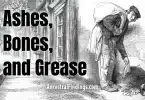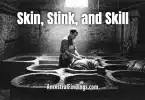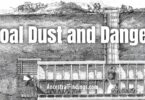Before the comforts of indoor plumbing and municipal sewage systems, someone had to do the dirty work. And by dirty, we mean truly revolting. The Night Soil Man was the one tasked with removing human waste from privy pits, outhouses, and cesspools—usually under cover of darkness when the smell might be slightly less offensive and when the public eye wouldn’t witness the mess.
The term “night soil” refers to human excrement that was collected before the days of flushing toilets. It piled up in backyard outhouses, chamber pots, and cesspools beneath tenement buildings and homes. Cities were packed with people, but sewage systems were almost nonexistent or in their earliest forms. This meant that a whole class of workers existed solely to shovel out and haul away human waste.
The Work of a Night Soil Man
The job was mostly nocturnal to avoid the public and bypass the worst of the odor under the sun. Dressed in old clothes or aprons made of oiled leather, Night Soil Men carried buckets, barrels, or large wooden tubs. Using long-handled dippers or shovels, they transferred the waste into wagons and carts. This foul cargo was then taken outside of city limits to be dumped or, more often, sold as fertilizer to nearby farms.
It was dangerous, too. Without gloves or masks, these workers were constantly exposed to bacteria and noxious gases. Falls into cesspits were not unheard of and often fatal. Explosions from built-up methane gas inside poorly ventilated vaults could take lives in an instant. Rats and insects were common occupational hazards. Many workers bore visible signs of their profession: skin infections, respiratory illness, or the unmistakable smell that lingered even after a wash.
Despite this, Night Soil Men were indispensable. In fact, their work often went unnoticed until a strike or shortage brought attention to just how necessary they were. In London during the 19th century, a temporary work stoppage resulted in a public health crisis within days. Similarly, in Philadelphia and New York, complaints about overflowing privies were a regular source of letters to the editor in early newspapers.
Famous Figures Connected to the Trade
While no U.S. presidents shoveled waste for a living, some prominent historical figures were closely tied to the world of sanitation and privy maintenance. At Mount Vernon, enslaved laborers under George Washington were tasked with emptying and cleaning privy vaults and maintaining the estate’s sanitation. These jobs, though not recorded in detail, were part of daily life on the plantation. It’s a sobering reminder of how the burden of the dirtiest work often fell on those with the fewest rights.
In England, the poet William Blake lived in Lambeth, a district where Night Soil Men frequently worked. Though he wasn’t one himself, his writings were peppered with references to the grimy and unpleasant underbelly of city life—likely influenced by the stench and labor he saw outside his window.
More recently, comedian and television host Mike Rowe famously highlighted the history of this profession in his series “Dirty Jobs,” helping to bring attention and respect to those who kept cities running, even if their names were never remembered.
The Use of Night Soil as Fertilizer
As disgusting as the job was, night soil had value. Farmers, particularly on the outskirts of urban centers, often paid for it. They mixed it with straw, sawdust, or even ash to reduce the odor and then spread it in their fields. This practice was especially common before the introduction of chemical fertilizers in the late 1800s. In some parts of the world—including China and Japan—human waste was seen as a precious agricultural commodity. In fact, landlords in rural Asia sometimes leased outhouse rights to traveling collectors who transported waste to rice paddies.
In the United States, public officials debated how to handle the vast amounts of waste produced by growing cities. By the 1860s, cities like Chicago and Baltimore began to formalize sanitation crews and explore underground sewage tunnels, reducing the need for night soil men—but never entirely eliminating them.
Finding Night Soil Men in the Records
You might not find the phrase “Night Soil Man” explicitly in early census records. Instead, look for occupations listed as:
- Scavenger
- Vault Cleaner
- Privy Digger
- Cesspool Emptier
- Sanitary Worker (in later years)
City directories from the 1800s sometimes mention these jobs more plainly. You may also find court records involving complaints about waste dumping or fights between sanitation crews and citizens. Newspapers are another source—Night Soil Men occasionally made the news when their wagons overturned, when someone fell ill from exposure, or when local politics involved sanitation funding.
Municipal archives, particularly in cities like Boston, New York, Philadelphia, and Chicago, kept detailed logs of contractors hired to clean public privies or service tenements. These may contain ledgers with names, addresses, and payment records. Immigrant laborers, particularly the Irish, were often found in these jobs in northern cities, sometimes recorded by name when trouble occurred, such as a brawl or a sanitation-related death.
In cities with large immigrant populations, night soil work was one of the few jobs available to new arrivals. It paid poorly but required no English, no references, and no formal training. In this way, it became a starting point for many first-generation Americans.
A Job to Be Remembered
This line of work was hidden from public view and largely erased from polite conversation, but it kept cities livable. If you find that an ancestor worked in sanitation before the 20th century, there’s a good chance they had a brush with night soil.
These people weren’t celebrated in their day, but their contribution to public health and infrastructure laid the groundwork for modern sanitation systems. The job was grueling, the conditions hazardous, and the respect minimal—but they did it anyway. And that’s something worth remembering.
Coming up next in this five-part series, we’ll head underground to trace the soot-covered lives of coal miners. Their world was just as dark—both literally and figuratively—and just as essential to the way our ancestors lived.






